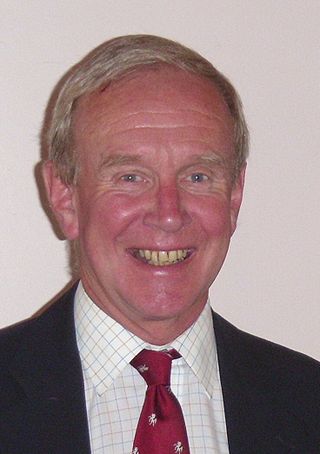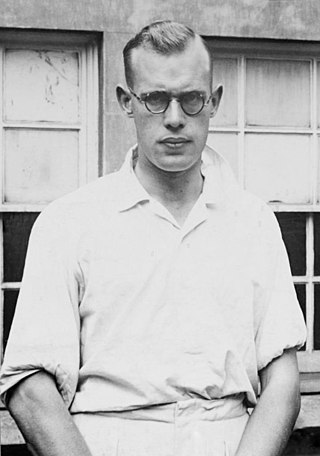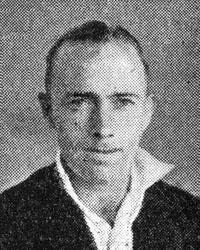Related Research Articles
Michael John Knight Smith, better known as M. J. K. Smith or Mike Smith, is an English former cricketer who was captain of Oxford University Cricket Club (1956), Warwickshire County Cricket Club (1957–1967) and the England cricket team (1963–1966). He was one of England's most popular cricket captains and, as he also played rugby union, Smith was England's last double international.

Walter Reginald Hammond was an English first-class cricketer who played for Gloucestershire in a career that lasted from 1920 to 1951. Beginning as a professional, he later became an amateur and was appointed captain of England. Primarily a middle-order batsman, Wisden Cricketers' Almanack described him in his obituary as one of the four best batsmen in the history of cricket. He was considered to be the best English batsman of the 1930s by commentators and those with whom he played; they also said that he was one of the best slip fielders ever. Hammond was an effective fast-medium pace bowler and contemporaries believed that if he had been less reluctant to bowl, he could have achieved even more with the ball than he did.

William Eric Hollies was an English cricketer, who is mainly remembered for taking the wicket of Donald Bradman for a duck in Bradman's final Test match innings, in which he needed only four runs for a Test average of 100. Hollies played all his first-class cricket career for Warwickshire, taking 2,323 wickets at less than 21 apiece.

Derek Leslie Underwood is an English former international cricketer, and a former President of the Marylebone Cricket Club (MCC).

Derek Shackleton was a Hampshire and England bowler. He took over 100 wickets in 20 consecutive seasons of first-class cricket, but only played in seven Tests for England. As of 2007, he has the seventh-highest tally of first-class wickets, and the most first-class wickets of any player who began his career after World War II. He holds the record for the most first-class wickets taken by any Hampshire player.

William Eric Bowes was an English professional cricketer active from 1929 to 1947 who played in 372 first-class matches as a right arm fast bowler and a right-handed tail end batsman. He took 1,639 wickets with a best performance of nine for 121 and completed ten wickets in a match 27 times. He scored 1,531 runs with a highest score of 43* and is one of very few major players whose career total of wickets taken exceeded his career total of runs scored. He did not rate himself as a fielder but he nevertheless held 138 catches.
Norman Gifford is a retired English cricketer, who played primarily as a left-arm spinner. Gifford played county cricket for Worcestershire, and Warwickshire County Cricket Clubs, and represented England in fifteen Test matches and two One Day International between 1964 and 1985.

Frederick John Titmus was an English cricketer, whose first-class career, mostly for Middlesex with a shortish stint for Surrey, spanned five decades. He was the fourth man after W.G. Grace, Wilfred Rhodes and George Hirst to take 2,500 wickets and make 20,000 runs in first-class cricket. Although he was best known for his off-spin, he was an accomplished lower-order batsman who deserved to be called an all-rounder, even opening the batting for England on six occasions. Outside cricket, Titmus was also a footballer; at one stage he was contracted to Watford as a professional, having earlier played for amateur club Leytonstone, and then for Chelsea as a junior.

Rohan Bholalall Kanhai is a Guyanese former cricketer of Indo-Guyanese origin, who represented the West Indies in 79 Test matches. He is widely considered to be one of the best batsmen of the 1960s. Kanhai featured on several great West Indian teams, playing alongside Sir Garfield Sobers, Roy Fredericks, Lance Gibbs, Clive Lloyd, and Alvin Kallicharran among others. C. L. R. James wrote in the New World Journal that Kanhai was "the high peak of West Indian cricketing development", and praised his "adventuresome" attitude. Kanhai was part of the West Indian team that won the inaugural, 1975 Cricket World Cup.
Lancelot Richard Gibbs is a former West Indies cricketer, one of the most successful spin bowlers in Test cricket history. He took 309 Test wickets, only the second player to pass 300, the first spinner to pass that milestone, and had an exceptional economy rate of under two runs per over.

David Arthur Allen was an English cricketer who played first-class cricket for Gloucestershire between 1953 and 1972. He also played 39 Test matches for England between 1960 and 1966.
Alan Christopher Smith, often known as A. C. Smith, is an English former Test cricketer, who appeared in six Tests matches for England. Primarily a wicket-keeper, Smith was also a capable right-handed middle-order batsman and right-arm seam bowler. Very unusually for a regular wicket-keeper, he was sometimes selected by Warwickshire as a frontline bowler.

Cecil "Sam" Cook was an English first-class cricketer who played for Gloucestershire County Cricket Club and in one Test match for the England cricket team.
James Langridge was an English cricketer who played for Sussex and England. He played in eight Test matches between 1933 and 1946.

Chris Old is a former English cricketer, who played 46 Tests and 32 ODIs from 1972 to 1981. A right-arm fast-medium bowler and lower order left-handed batsman, Old was a key feature of the Yorkshire side between 1969 and 1983, before finishing his career at Warwickshire in 1985. As a Test bowler for England he took 143 wickets, and scored useful runs in the famous 1981 Ashes series' Headingley victory.
Edric "Eddie" Leadbeater was an English cricketer who played in two Tests in 1951. He was born in Lockwood, Huddersfield, West Riding of Yorkshire, and died in Huddersfield.
Thomas William Cartwright was an English cricketer. Playing largely for Somerset and Warwickshire, he took over 1,600 wickets as a medium-pace bowler, though he began his career as a top-order batsman, and was capable enough with the bat to score seven hundreds including a double-century. He played in five Tests for England in 1964 and 1965. His withdrawal from the 1968–69 tour to South Africa led to his replacement in the touring team by Basil D'Oliveira, whose inclusion precipitated the sporting isolation of South Africa until apartheid was abolished.

Colin Milburn was an English cricketer, who played in nine Test matches for England, before an accident led to the loss of much of his sight and prompted his retirement.

Richard Anthony Hutton is a former English cricketer, who played in five Test matches for the England cricket team in 1971. A right-handed batsman and right-arm seam bowler, Hutton's bowling was probably his stronger discipline, but he was considered an all-rounder. He played first-class cricket for Yorkshire County Cricket Club. He is the son of cricketer Len Hutton, described by Wisden Cricketers' Almanack as "one of the greatest batsmen in the history of cricket."
The Indian cricket team toured England in the 1971 season and played 19 first-class fixtures, winning 7, losing only one and drawing 11.
References
- 1 2 3 4 Bateman, Colin (1993). If The Cap Fits. Tony Williams Publications. p. 99. ISBN 1-869833-21-X.
- ↑ Australia v England, Champions Trophy SF 2009, Commentary
- ↑ Frindall, Bill (2009). Ask Bearders. BBC Books. pp. 35–36. ISBN 978-1-84607-880-4.
- ↑ England v India, 2nd Test, 1971
- ↑ England v India, 3rd Test, 1971
- ↑ Warwickshire v Gloucestershire, 1974
- ↑ ESPNcricinfo: Reverse swinging in the court
- ↑ "No. 59282". The London Gazette (Supplement). 31 December 2009. p. 18.